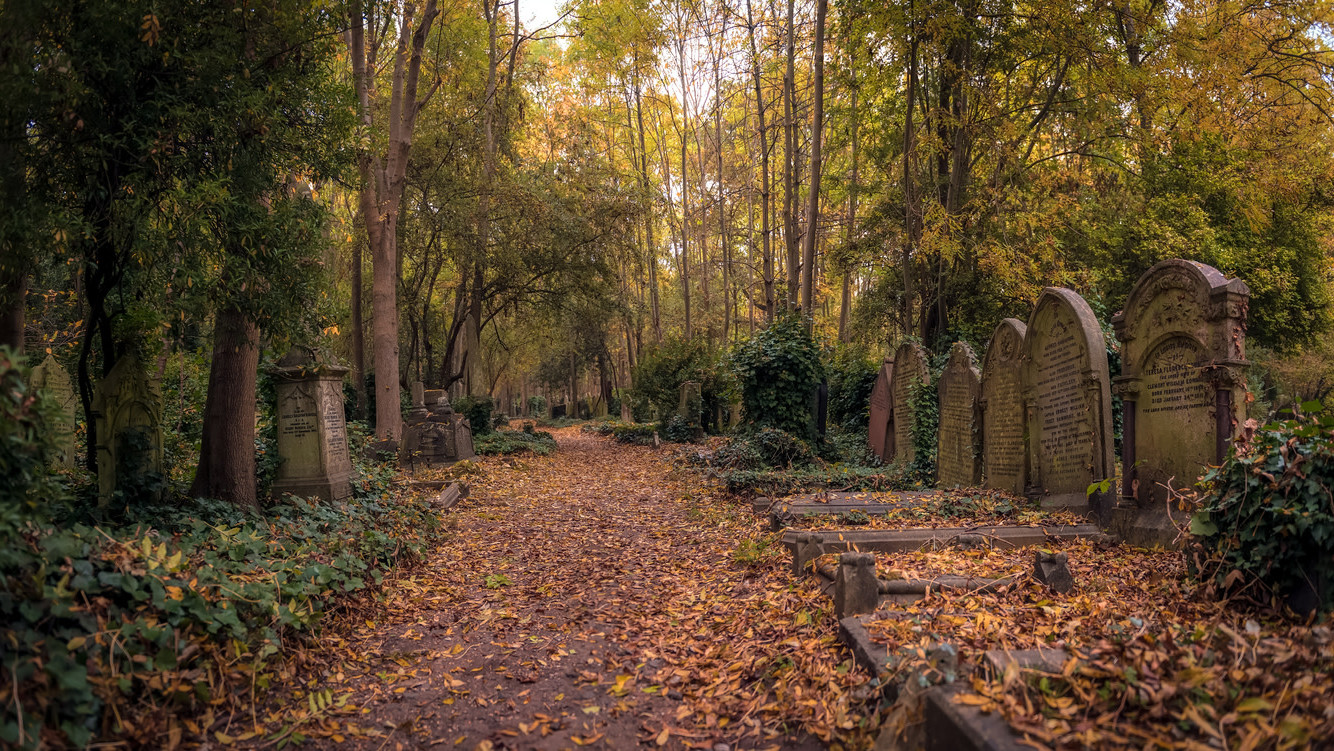From Beyond The Graveyard: The Rich Roots Of Cemetery Terroir
Last year, Jamie Oakes, a master distiller at Tamworth, a craft distillery in New Hampshire, was out tapping maples with someone he calls a local old-timer—"I don't think he'd like us using his name," he explains—when he spotted a sun-dappled stand of old maples, apparently surging with sap. "How about those over there?" he asked.
The old-timer suddenly grew stony-faced and serious.
"Nope. Nope. We don't tap those trees," he warned. The maple grove shaded a cluster of unmarked colonial-era graves. Local lore and custom forbade disturbing the trees and waking the spirits slumbering beneath.
Oakes and his fellow distiller Matt Power decided to tempt the wrath of angry colonial ghosts and tap the forbidden maples anyway. They used the syrup to flavor a 3-year-old rye they call Graverobber Unholy Rye. They played up the limited-edition spirit's spooky origins and packaged it in a cute little pine coffin with a black-and-white illustration on the label of a full moon rising over crooked gravestones.
Tamworth's Graverobber Rye isn't the only way to get a taste of death. Brooklyn's Green-Wood cemetery sells its own Sweet Hereafter honey, made by the bees who gorge themselves on the flowers that grow by graves. In Oakland, California, the local Catholic diocese sells wine from grapes planted as part of a beautification project at Holy Sepulchre Cemetery. A community gardening group in the U.K., Incredible Edible Todmorden, cultivates vegetables and flowers in local graveyards. Londoners forage for berries to flavor sloe gin in the Tower Hamlets Cemetery near the center of the city.
Dirt from haunted or hallowed ground—that is, cemeteries—has long been used in pagan rituals and witchcraft for casting spells and for protection from spirits. But is there anything unique about the soil in graveyards or the food that grows in it? Wine aficionados talk about terroir—or "taste of place," the combination of soil and environment that gives each vineyard its specific character. Is there such a thing as graveyard terroir?
Researchers studying the dirt in cemeteries—sometimes called necrosol—have found distinct qualities to these soils. The soil in contemporary, active cemeteries may contain pathogens and hazardous materials, including trace metals, carcinogenic embalming agents, and microplastics—the toxic detritus of modern life. But in older cemeteries, these hazards dissipate and other properties emerge. A recent Polish study of soil in two abandoned cemeteries, including one that was a mass grave for German soldiers in 1914 and 1945, measured significantly higher levels of phosphorus, nitrogen, and organic carbon than in surrounding fields, all indications of greater soil fertility.
Old graveyards are lush not only because the soil is fortified by dead bodies. The "garden cemetery movement" of the 19th century that built classic American cemeteries—like Mount Auburn outside of Boston or Laurel Hill in Philadelphia—envisioned turning these solemn spaces into recreational areas. These were the original city parks, green spaces where crowded urban dwellers could romp, picnic, and enjoy the fresh air. Many of these old cemeteries are no longer actively landscaped and have passed into a phase of benign neglect, making them a haven for plants and wildlife.
They're also prime spots for foraging wild foods and herbs. Marla Emery, a geographer who has studied urban foragers, described a visit to a Queens, New York cemetery in a 2015 interview with Urban Omnibus, a publication of the Architectural League Of New York. "Areas where early burials took place are relatively unmanicured, and there's a great diversity of species, so you know that there's no broad-leaf herbicide being applied," she says. "In one cemetery where the headstones all showed burials in the mid-1800s, I could easily identify half a dozen species that were either food or medicine in one square meter of ground."

Arley Marks, co-owner of the Brooklyn mead bar Honey's, led a recent mushroom-hunting expedition to Green-Wood, searching for hen-of-the-wood, or maitake, mushrooms.
I asked him why he chose the cemetery as his stomping grounds. "Old graveyards are some of the only places in New York where you can find big, old oak trees," he says. These are the kind of trees where maitake thrive. During a foraging trip to Swan's Point cemetery in Providence, Rhode Island a few years ago, "we found like five or six mushrooms that were over 30 pounds each." Since then, he says, "I'm drawn to [graveyards] like a gold rush."
Instead of resisting our own decay with embalming fluid and hermetically sealed coffins, perhaps we should embrace our destiny as soil. Green burials, which eschew embalming, coffins, and other trademarks of modern mortuary science, are growing in popularity. Alkaline hydrolysis—a carbon-friendly alternative to cremation, also known as "aquamation"—converts bodies into a nutrient-rich fluid that can be used as fertilizer. Earlier this year, Washington became the first state in the U.S. to allow "aboveground decomposition," that is, composting bodies into fertile soil. As the website for Recompose, a company pioneering this technology, explains, microbial-assisted composting "gently converts human remains into soil, so that we can nourish new life after we die."
Sonia Baker, an environmental activist in her 80s who favors the process, told The Seattle Times last year that after she dies, she would like to become soil that will nourish an old Gravenstein apple tree in her granddaughter's yard. "That kind of tree makes the best apple pies," she says—forever putting a new spin on "grandma's apple pie."
Maybe you don't agree; maybe this icks you out. But as Jacob Lahne, a professor of food science and technology at Virginia Tech wrote to me in an email, "What do we do when so much of the world is more or less a graveyard?"
